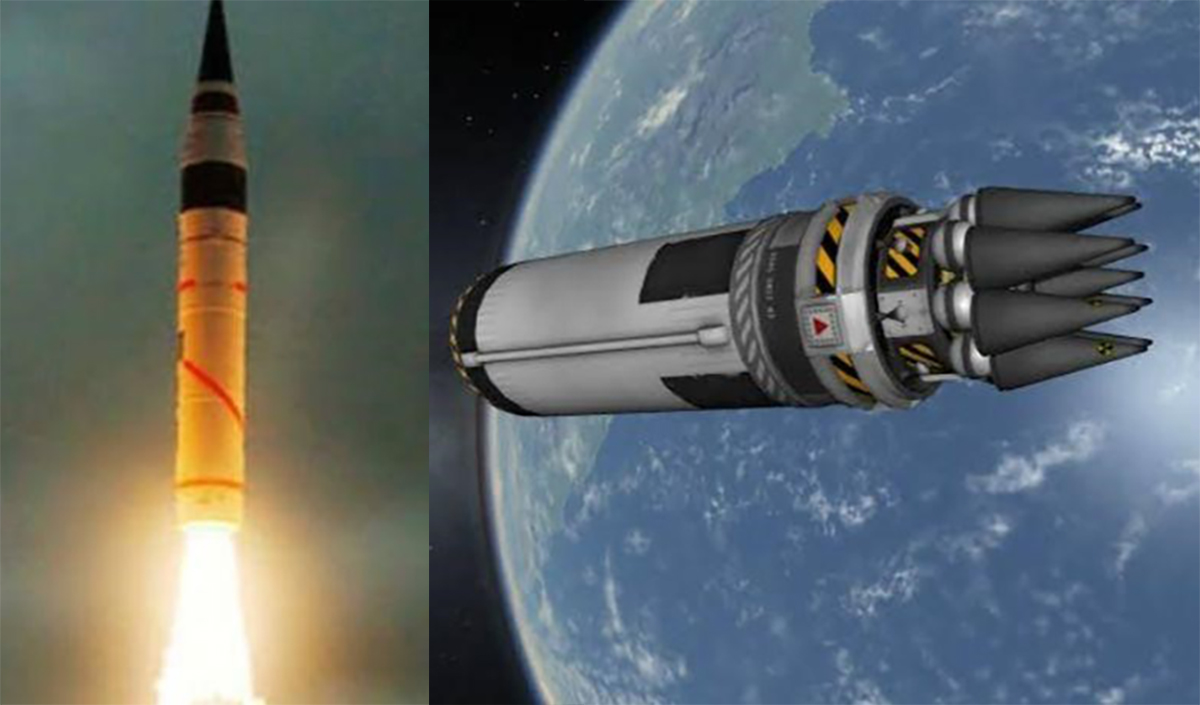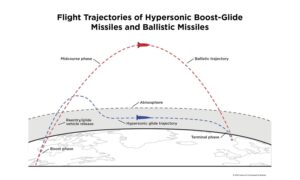Sputnik News, a Russian news agency and radio broadcast service, sought inputs on the Analakshya Project.
Article on the subject:-
RUSSIAN USE OF THE ORESHNIK MISSILE AND ITS STRATEGIC IMPLICATIONS
The development and deployment of the Oreshnik missile, a hypersonic, intermediate-range ballistic missile (IRBM) by Russia, marks a significant shift in global military power dynamics. First publicly revealed in November 2024 during a strike on Ukraine, the Oreshnik has been described as a highly advanced missile capable of carrying both conventional and nuclear warheads with hypersonic speeds exceeding Mach 10. The missile’s introduction highlights Russia’s continued push towards leveraging next-generation military technology to assert its influence, challenge adversaries, and fortify its strategic deterrence capabilities
Oreshnik Missile
Hypersonic Speed and Manoeuvrability. The Oreshnik missile stands out for its hypersonic velocity, with reports indicating speeds of around 2.5 to 3 kilometers per second (Mach 10). This speed renders it nearly immune to current air defence systems, as interception at such velocities requires cutting-edge detection and response technologies. Hypersonic missiles like Oreshnik can also perform mid-flight manoeuvres, making their trajectory unpredictable and further complicating interception efforts.
Multiple Independently Targetable Reentry Vehicles (MIRVs). Oreshnik reportedly carries multiple independently targetable warheads (MIRVs), with estimates ranging from three to six warheads per missile. These MIRVs can be programmed to strike different targets simultaneously or overwhelm defence systems through sheer volume. The MIRV capability enhances the missile’s destructive potential, especially in scenarios where multiple high-value targets are prioritized.
Intermediate Range and Versatility. The missile’s range is believed to fall between 3,000 and 5,000 kilometers, making it an intermediate-range ballistic missile (IRBM). This range covers a significant portion of Europe and parts of Asia, but falls short of reaching the United States. However, this strategic range allows Russia to maintain a strong regional deterrence posture, capable of targeting European NATO members and other adversaries within proximity.
Operational Deployment and Combat Testing. Russia’s first known operational use of the Oreshnik missile occurred in November 2024, when it was deployed against the Ukrainian city of Dnipro. According to reports, this strike served as a combat test for the missile in a non-nuclear configuration. Russian President Vladimir Putin claimed that the test was successful, with the missile reaching its intended target without interception. The deployment was designed to demonstrate Russia’s capability to strike with precision and lethality, even in high-pressure combat environments. This deployment signals a shift in Russian military doctrine, emphasising the operational use of hypersonic weapons for both deterrence and offensive purposes. By using Oreshnik in combat, Russia showcased its ability to field advanced missile systems under real-world conditions, sending a clear message to both adversaries and allies regarding its military prowess.
Strategic Implications
Strengthening Regional Deterrence. The Oreshnik missile significantly enhances Russia’s ability to deter regional adversaries. Its intermediate range allows Russia to project power across Eastern Europe, the Middle East, and parts of Central Asia, creating a buffer zone of influence where neighbouring countries must consider the risk of hypersonic strikes. This capability provides Russia with a powerful bargaining chip in diplomatic negotiations, particularly in contexts involving NATO expansion, territorial disputes, and geopolitical tensions.
Challenging NATO’s Defence Systems. NATO’s current air defence systems are primarily designed to intercept traditional ballistic and cruise missiles. The deployment of Oreshnik, with its hypersonic speed and manoeuvrability, presents a significant challenge to these systems. NATO countries may be forced to accelerate the development of hypersonic defence systems or pursue alternative deterrent measures, increasing military expenditures and deepening the arms race between Russia and Western powers.
Arms Control Frameworks. The introduction of Oreshnik further undermines the already fragile state of global arms control agreements. In 2019, both Russia and the United States withdrew from the Intermediate-Range Nuclear Forces (INF) Treaty, which previously prohibited the development of missiles with ranges between 500 and 5,500 kilometers. The Oreshnik missile, with its intermediate range and potential nuclear capability, exacerbates concerns over the proliferation of such systems and the absence of regulatory frameworks to mitigate their deployment.
Global Reactions and Countermeasures
United States and NATO. In response to the growing hypersonic threat, the United States and NATO have intensified efforts to develop next-generation missile defence systems. Programs focusing on space-based sensors, directed-energy weapons, and hypersonic interceptors are being accelerated to counteract Russia’s advancements. Additionally, NATO may consider deploying more conventional deterrents, such as forward-deployed forces and ballistic missile defence systems in Eastern Europe.
China’s Perspective. China, a close military partner of Russia, may view the Oreshnik missile as an opportunity for technological collaboration. Given its own hypersonic weapon developments, China could seek to integrate lessons from Oreshnik’s deployment into its missile programs. Alternatively, the missile’s success might prompt China to accelerate its efforts to match or surpass Russian capabilities, potentially increasing regional tensions in Asia.
India’s Strategic Calculations. For India, the development of the Oreshnik missile poses both a strategic challenge and an opportunity. India’s focus on developing its own hypersonic weapons, such as the Hypersonic Technology Demonstrator Vehicle (HSTDV), aligns with the need to counter future threats from China. Furthermore, India may consider enhancing its missile defence systems and investing in early-warning systems capable of detecting hypersonic threats.
Broader Implications for Global Stability
Escalation of the Hypersonic Arms Race. The successful deployment of Oreshnik signals the start of a new era in missile technology, prompting other nations to accelerate their hypersonic weapons programs. This arms race could destabilize existing power balances, increasing the likelihood of miscalculations and accidental escalations during geopolitical conflicts.
Shift in Military Doctrine. The introduction of hypersonic missiles like Oreshnik is reshaping military doctrines worldwide. Traditional reliance on nuclear deterrence is now supplemented by hypersonic weapons, capable of delivering swift and precise strikes without the political fallout associated with nuclear weapons. This shift is likely to result in the development of new tactical doctrines.
Conclusion. The Oreshnik missile represents a bold leap in Russia’s military capabilities, reflecting the country’s commitment to leveraging advanced technologies for strategic dominance. Its deployment in Ukraine served as a clear demonstration of Russia’s readiness to use hypersonic missiles in both conventional and nuclear contexts, reshaping the global security landscape. As nations around the world grapple with the implications of this new weapon, the Oreshnik missile underscores the urgent need for renewed international dialogue on arms control and missile defence. Without such measures, the risk of a hypersonic arms race escalating into broader conflict remains a profound concern for global stability.
Inputs:-
(The views expressed are of the Individual, not IAF or GOI).
-
- The missile’s ability to carry multiple homing warheads and reach extreme temperatures of 4,000°C presents a significant threat to conventional missile defence systems.
- India’s military establishment would likely view Russia’s Oreshnik missile with a strategic interest.
- India may closely study the technology behind Oreshnik’s hypersonic speed, multi-warhead capabilities, and extreme heat resistance.
- India might assess this development in terms of its missile defence upgrades and hypersonic capabilities development programs.
- This could drive India to accelerate its hypersonic programs, such as the HSTDV (Hypersonic Technology Demonstrator Vehicle), and enhance its missile defence systems.
- This could influence India’s strategic partnerships and technology acquisition efforts, particularly bolstering its Ballistic Missile Defence and hypersonic deterrence programs.
- India would be careful about directly acquiring the Oreshnik missile due to its commitment to Indigenous defence development under Atmanirbhar Bharat.
- India may seek technology partnerships with friendly nations to develop home-grown versions of similar advanced missile systems while maintaining strategic independence.
Your valuable comments are most welcome.
For regular updates, please register your email here:-
References and credits
To all the online sites and channels.
References:-
- BelTA News. (2024). Oreshnik: A Precision Weapon Comparable to Nuclear Strike Capability.
- Asia Times. (2024). Russian Oreshnik Missile: A Warning to NATO, US, and Ukraine.
- Komsomolskaya Pravda via BelTA. (2024). Military Expert Commentary on the Oreshnik Missile’s Impact in Ukraine.
- Global Security Review. (2024). Hypersonic Missiles and Modern Warfare: The Russian Edge.
- Military Balance Report (2024). International Institute for Strategic Studies.
Disclaimer:
Information and data included in the blog are for educational & non-commercial purposes only and have been carefully adapted, excerpted, or edited from reliable and accurate sources. All copyrighted material belongs to respective owners and is provided only for wider dissemination.




